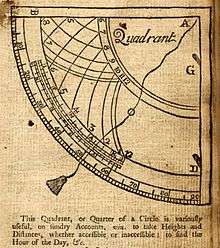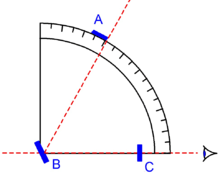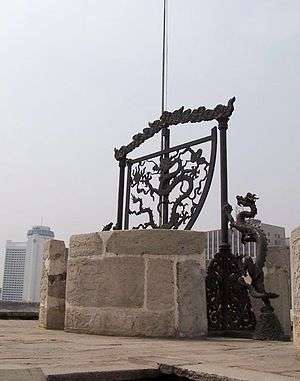Quadrant (instrument)

A quadrant is an instrument that is used to measure angles up to 90°. It was originally proposed by Ptolemy as a better kind of astrolabe.[1] Several different variations of the instrument were later produced by medieval Muslim astronomers.
Types
There are several types of quadrants:
- Mural quadrants used for measuring the altitudes of astronomical objects.
- Large frame-based instruments used for measuring angular distances between astronomical objects.
- Geometric quadrant used by surveyors and navigators.
- Davis quadrant a compact, framed instrument used by navigators for measuring the altitude of an astronomical object.
They can also be classified as[2]

- Altitude - The plain quadrant with plumb line, used to take the altitude of an object.
- Gunner's - A type of clinometer used by an artillerist to measure the elevation or depression angle of a gun barrel of a cannon or mortar, both to verify proper firing elevation, and to verify the correct alignment of the weapon-mounted fire control devices.
- Gunter's - A quadrant used for time determination. Invented by Edmund Gunter in 1623.
- Islamic - King identified four types of quadrants that were produced by Muslim astronomers.[3]
- The sine quadrant (Arabic: Rubul Mujayyab) - also known as the "Sinecal Quadrant" – was used for solving trigonometric problems and taking astronomical observations. It was developed by al-Khwarizmi in 9th century Baghdad and prevalent until the nineteenth century. Its defining feature is a graph-paper like grid on one side that is divided into sixty equal intervals on each axis and is also bounded by a 90 degree graduated arc. A cord was attached to the apex of the quadrant with a bead, for calculation, and a plumb bob. They were also sometimes drawn on the back of astrolabes.
- The universal (shakkāzīya) quadrant – used for solving astronomical problems for any latitude: These quadrants had either one or two sets of shakkāzīya grids and were developed in the fourteenth century in Syria. Some astrolabes are also printed on the back with the universal quadrant like an astrolabe created by Ibn al-Sarrāj.
- The horary quadrant – used for finding the time with the sun: The horary quadrant could be used to find the time either in equal or unequal (length of the day divided by twelve) hours. Different sets of markings were created for either equal or unequal hours. For measuring the time in equal hours, the horary quadrant could only be used for one specific latitude while a quadrant for unequal hours could be used anywhere based on an approximate formula. One edge of the quadrant had to be aligned with the sun, and once aligned, a bead on the plumbline attached to the centre of the quadrant showed the time of the day. An example exists dated 1396, from European sources (Richard II of England).[4] The oldest horary quadrant was found during an excavation in 2013 in the Hanseatic town of Zutphen (Netherlands) and is dated ca. 1300 and is in the local Stedelijk Museum in Zutphen.).[5]
- The astrolabe/almucantar quadrant – a quadrant developed from the astrolabe: This quadrant was marked with one half of a typical astrolabe plate as astrolabe plates are symmetrical. A cord attached from the centre of the quadrant with a bead at the other end was moved to represent the position of a celestial body (sun or a star). The ecliptic and star positions were marked on the quadrant for the above. It is not known where and when the astrolabe quadrant was invented, existent astrolabe quadrants are either of Ottoman or Mamluk origin, while there have been discovered twelfth century Egyptian and fourteenth century Syrian treatises on the astrolabe quadrant. These quadrants proved to be very popular alternatives to astrolabes.
Geometric quadrant

The geometric quadrant is a quarter-circle panel usually of wood or brass. Markings on the surface might be printed on paper and pasted to the wood or painted directly on the surface. Brass instruments had their markings scribed directly into the brass.
For marine navigation, the earliest examples were found around 1460. They were not graduated in degrees but rather had the latitudes of the most common destinations directly scribed on the limb. When in use, the navigator would sail north or south until the quadrant indicated he was at the destination's latitude, turn in the direction of the destination and sail to the destination maintaining a course of constant latitude. After 1480, more of the instruments were made with limbs graduated in degrees.[6]
Along one edge there were two sights forming an alidade. A plumb bob was suspended by a line from the centre of the arc at the top.
In order to measure the altitude of a star, the observer would view the star through the sights and hold the quadrant so that the plane of the instrument was vertical. The plumb bob was allowed to hang vertical and the line indicated the reading on the arc's graduations. It was not uncommon for a second person to take the reading while the first concentrated on observing and holding the instrument in proper position.
The accuracy of the instrument was limited by its size and by the effect the wind or observer's motion would have on the plumb bob. For navigators on the deck of a moving ship, these limitations could be difficult to overcome.
Solar observations

In order to avoid staring into the sun to measure its altitude, navigators could hold the instrument in front of them with the sun to their side. By having the sunward sighting vane cast its shadow on the lower sighting vane, it was possible to align the instrument to the sun. Care would have to be taken to ensure that the altitude of the centre of the sun was determined. This could be done by averaging the elevations of the upper and lower umbra in the shadow.
Back observation quadrant
In order to perform measurements of the altitude of the sun, a back observation quadrant was developed.[6]
With such a quadrant, the observer viewed the horizon from a sight vane (C in the figure on the right) through a slit in the horizon vane (B). This ensured the instrument was level. The observer moved the shadow vane (A) to a position on the graduated scale so as to cause its shadow to appear coincident with the level of the horizon on the horizon vane. This angle was the elevation of the sun.
Framed quadrant

Large frame quadrants were used for astronomical measurements, notably determining the altitude of celestial objects. They could be permanent installations, such as mural quadrants. Smaller quadrants could be moved. Like the similar astronomical sextants, they could be used in a vertical plane or made adjustable for any plane.
When set on a pedestal or other mount, they could be used to measure the angular distance between any two celestial objects.
The details on their construction and use are essentially the same as those of the astronomical sextants; refer to that article for details.
Navy: Used to gauge elevation on ships cannon, the quadrant had to be placed on each gun's trunnion in order to judge range, after the loading. The reading was taken at the top of the ship's roll, the gun adjusted,and checked, again at the top of the roll, and he went to the next gun, until all that were going to be fired were ready. The ship's Gunner was informed, who in turn informed the captain...You may fire when ready...at the next high roll, the cannon would be fired.
In more modern applications, the quadrant is attached to the trunion ring or of a large naval gun to align it to benchmarks welded to the ship's deck. This is done to ensure firing of the gun hasn't "warped the deck." A flat surface on the mount gunhouse or turret is also checked against benchmarks, also, to ensure large bearings and/or bearing races haven't changed... to "calibrate" the gun.
See also
References
- ↑ The history of the telescope Henry C. King, Harold Spencer Jones Editor Harold Spencer Jones Courier Dover Publications, 2003 ISBN 0-486-43265-3, ISBN 978-0-486-43265-6
- ↑ Gerard L'E. Turner, Antique Scientific Instruments, Blandford Press Ltd. 1980 ISBN 0-7137-1068-3
- ↑ King, D. (1987), ‘Islamic Astronomical Instruments’, Variorum, London, repr. Aldershot: Variorum, 1995.
- ↑ 14th century timepiece unearthed in Qld farm shed, Clayton Bloom, ABC News Online, accessed 10 November 2011
- ↑ John Davis - The Zutphen Quadrant – A very early equal-hour instrument excavated in The Netherlands - British Sundial Society 89. Volume 26(i) March 2014; Fermin, B., D. Kastelein. Het Zutphense Kwadrant. Archeologisch onderzoek in de gracht van de ringwalburg op de Houtmarkt te Zutphen. Zutphense Archeologische Publicaties 80. Gemeente Zutphen 2013
- 1 2 May, William Edward, A History of Marine Navigation, G. T. Foulis & Co. Ltd., Henley-on-Thames, Oxfordshire, 1973, ISBN 0-85429-143-1
- Maurice Daumas, Scientific Instruments of the Seventeenth and Eighteenth Centuries and Their Makers, Portman Books, London 1989 ISBN 978-0-7134-0727-3
External links
- Gunter's Quadrant Article on the Gunter's Quadrant (PDF)
- Gunter's Quadrant Simulation of Gunter's Quadrant (requires Java)
- A working quadrant in coin form
- Richard II (1396) era equal hour horary quadrant (pictures):